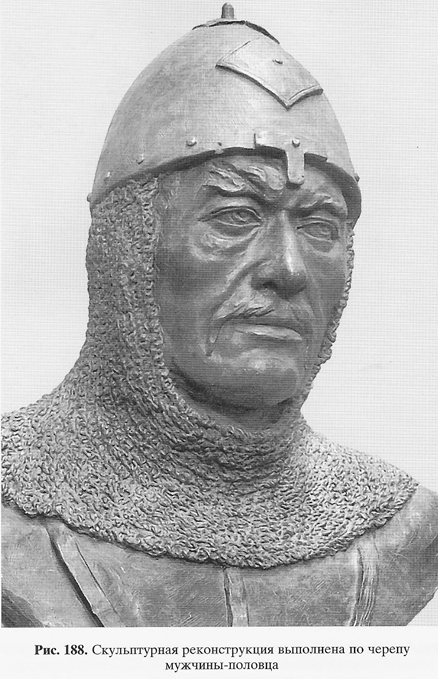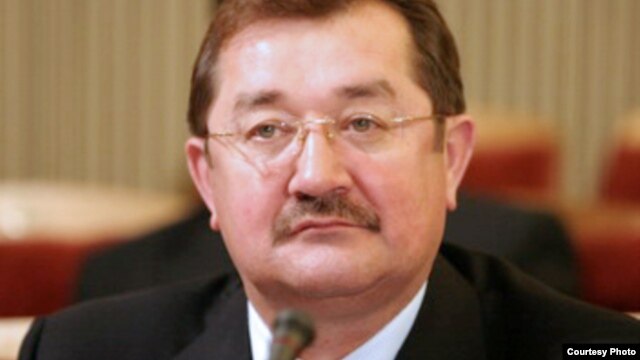Kipchak are Mongoloid/Caucasoid hybrid
Printed From: History Community ~ All Empires
Category: Regional History or Period History
Forum Name: Steppe Nomads and Central Asia
Forum Discription: Nomads such as the Scythians, Huns, Turks & Mongols, and kingdoms of Central Asia
URL: http://www.allempires.com/forum/forum_posts.asp?TID=33196
Printed Date: 08-Jun-2024 at 19:11
Software Version: Web Wiz Forums 9.56a - http://www.webwizforums.com
Topic: Kipchak are Mongoloid/Caucasoid hybrid
Posted By: MrButlerKing
Subject: Kipchak are Mongoloid/Caucasoid hybrid
Date Posted: 01-Feb-2013 at 07:29
  The famous "Polovtsian of Sarkel" (White Tower). M.Gerasimova reconstruction. In times of war Cumans, Pechenegs Glowe put on a fur hat with a high-top shoulders - inside-out cover of sheepskin. Oblique impact saber dense fleece is not hacked, an arrow stuck.  Note: Polovsty in the Russian word for Kypchaks. Translating Russian to English "Anthropological of Kipchaks, like other Turkic their predecessors in the Northern Black Sea was probably mixed. Thus, SA Pletnev, describing several graves in the Polovtsian White Vezhe notes Mongoloidness buried and concluded "the presence of a component in the Mongolian Polovtsian environment. However, she and other researchers believe that the whole Black Sea Kipchaks in anthropological terms, is not much different from the previous nomadic population of the Northern Black Sea Region VIII - X in the beginning., And most fully characterized Polovtsy Caucasoid appearance. Ukrainian anthropologist A. Shevchenko said that in the guise of Polovtsian originally joined racial characteristics Caucasoid and Mongoloid, namely a broad flat face and expressive protruding nose. Historian EP Alekseev drew attention to the fact that European Kipchak stone images have both mongoloid person, and Caucasoid. However, in its view, the Kipchaks, who moved to Georgia in the first half of the XII century. were predominantly Caucasian appearance, another Georgian sources pointed to their Mongoloid, as later noted an unusual appearance of the Mongols. Note that Caucasoid appearance was also pretty much typical for Asian Kipchak, before the start of their movement in Europe. According to anthropologist VV Ginzburg population of East Kazakhstan VIII-X centuries. Presumably referring to Kimak-Kipchak Khanate, was characterized by a predominance of Caucasoid features, although here there were also carriers of the Mongoloid and transition types. Also in this regard can also lead to historian and archaeologist BA Litvinskiy which characterizes anthropological image of the medieval population of Kazakhstan, wrote the following: "... most of the local Turkic ethnic entities time remained Caucasoid, preserving genetic features that precede them tribal people. Turning to the overall ratio of the two major racial components in the physical appearance of the local inhabitants of the reporting time, the conditional share of Mongoloid elements as a whole amounted to 1/3 of populations." . A number of local groups impurity level reached half of the total gene pool. In some series of crania, particularly pritobolskoy Series VIII-X centuries. n. e. from Northern Kazakhstan, the conditional share Mongoloid reached 2/3 of the total weight. Ancient anthropological Kypchak resembles Tatars of Western Siberia speaking western Kypchaks language such as Bashkir Tatars than to Eastern Kazakhs, Kyrgyz, Karakalpak       |
Replies:
Posted By: tomb_seeker
Date Posted: 27-Nov-2014 at 08:55
|
as i know, tatars are kipchaks |